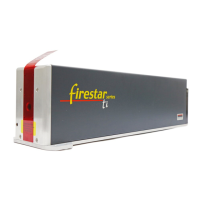maintenance/
troubleshooting
416
Synrad Firestar ti-Series operator’s manual
Troubleshooting
Ensure that DC power cable connections are tight and verify that +48 VDC is available on the power sup-
ply terminals under full-load (100% duty cycle) conditions.
■ A reverse voltage connection caused internal fuses(s) inside the laser too blow.
Contact SYNRAD Customer Service for information about accessing the mini automotive-type blade
fuses (Littelfuse 997020 or equivalent) inside the ti-Series laser.
Beam delivery optics
Caution
possible
equipment
damage
If you operate your laser or marking head in a dirty or dusty environ-
ment, contact SYNRAD about the risks of doing so and precautions
you can take to increase the longevity of your laser, marking head,
and associated optical components.
Danger
serious
personal
injury
Ensure that DC power to the laser is turned off and locked out before
inspecting optical components in the beam path. Invisible CO
2
laser
radiation is emitted through the aperture. Corneal damage or blind-
ness may result from exposure to laser radiation.
Symptom:
■ The laser loses power over time; laser output power must be increased to maintain performance.
Possible Causes:
■ Beam delivery optics are coated by vapor residue or debris.
Shut down the laser and carefully inspect each optic in the beam delivery path, including the laser’s output
coupler. Remember that optics are fragile and must be handled carefully; preferably by the mounting ring
only. If the optic requires cleaning, then refer back to Maintenance for cleaning instructions. Use only
recommended cleaning materials (see Table 4-1) to prevent scratching delicate optical surfaces.
If the focusing optic is pitted, it must be replaced immediately. Because of the extremely high power den-
sity of Firestar lasers, pits or debris on the lens surface may absorb enough energy from the focused beam to
crack the lens. If this happens, other optics in the beam path may be contaminated or damaged as well.

